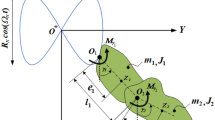Abstract
In this paper, the authors have studied dynamic responses of a parametric pendulum by means of analytical methods. The fundamental resonance structure was determined by looking at the undamped case. The two typical responses, oscillations and rotations, were investigated by applying perturbation methods. The primary resonance boundaries for oscillations and pure rotations were computed, and the approximate analytical solutions for small oscillations and period-one rotations were obtained. The solution for the rotations has been derived for the first time. Comparisons between the analytical and numerical results show good agreements.
Similar content being viewed by others
References
Xu, X., Wiercigroch, M., Cartmell, M.P.: Rotating orbits of a parametrically-excited pendulum. Chaos Solitons Fractals 23, 1537–1548. (2005)
Bishop, S.R., Sofroniou, A., Shi, P.: Symmetry-breaking in the response of the parametrically excited pendulum model. Chaos Solitons Fractals 25, 257–264 (2005)
Clifford, M.J., Bishop, S.R.: Locating oscillatroy orbits of the parametrically-excited pendulum. J. Aust. Math. Soc. Ser. B – Appl. Math. 37, 309–319. (1996)
Clifford, M.J., Bishop, S.R.: Approximating the excape zone for the parametrically excited pendulum. J. Sound Vib. 172(4), 572–576 (1994)
Szemplí'nska-Stupnicka, W., Tyrkiel, E.: The oscillation-rotation attractors in the forced pendulum and their peculiar properties. Int. J. Bifurcation and Chaos 12, 159–168 (2002)
Szemplí'nska-Stupnicka, W., Tyrkiel, E.: Common features of the onset of the persistent chaos in nonlinear oscillators: a phenomenological approach. Nonlinear Dyn. 27, 271–293 (2002)
Szemplí'nska-Stupnicka, W., Zubrzycki, A., Tyrkiel, E.: Properties of chaoteic and regular boundary crisis in dissipative driven nonlinear sscillators. Nonlinear Dyn. 19, 19–36 (1999)
Koch, B.P., Leven, R.W., Pompe, B., Wilke, C.: Experimental evidence for chaotic behavior of a parametrically forced pendulum. Phys. Lett. A 96(5) 219–224 (1983)
Leven, R.W., Pompe, B., Wilke, C., Koch, B.P.: Experiments on periodic and chaotic motion of a parametrically driven pendulum. Physica D 16, 371–384 (1985)
Yabuno, H., Miura, M., Aoshima, N.: Bifurcation in an inverted pendulum with tilted high-frequency excitation: analytical and experimental investigations on the symmetry-breaking of the bifurcation. J. Sound Vib. 273, 493–513 (2004)
Koch, B.P., Leven, R.W.: Subharmonic and homoclinic bifurcations in a parametrically forced pendulum. Physica D 16, 1–13 (1984)
Miles, J.: On resonant rotation of a weakly damped pendulum. J. Sound Vib. 280, 401–406 (2005)
Nusse, H.E., Yorke, A.Y.: Dynamics: Numerical Explorations, Springer-Verlag, New York, Inc. (1997)
Xu, X.: Nonlinear dynamics of parametric pendulum for wave energy extraction, PhD thesis, University of Aberdeen. (2005)
Author information
Authors and Affiliations
Corresponding author
Rights and permissions
About this article
Cite this article
Xu, X., Wiercigroch, M. Approximate analytical solutions for oscillatory and rotational motion of a parametric pendulum. Nonlinear Dyn 47, 311–320 (2007). https://doi.org/10.1007/s11071-006-9074-4
Received:
Accepted:
Published:
Issue Date:
DOI: https://doi.org/10.1007/s11071-006-9074-4



